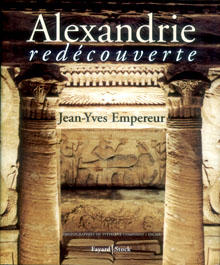- Alexandria Rediscovered
- Jean-Yves Empereur
Published in English by The British Museum Press (UK) and George Braziller (US),1998

Equal to Athens in terms of influence and the political rival of Rome, a home to the great cultures that gave birth to the West (Hellenism, Judaism and Christianity, not forgetting the mysteries of eternal Egypt), the biggest city of the eastern Mediterranean, the town of Alexander and Cleopatra amazed the travellers of antiquity by its size, its mass of population and above all its splendour. But the passage of history has been cruel: there are no visible remains of the Library, of the Museum, of the palaces of the Ptolemies, even of the many temples of ages gone by. Moreover, the discoveries of archaeologists over the past two centuries have been modest.
It is only during the last ten years with excavations employing modern methodology that Jean-Yves Empereur and his team have advanced our knowledge of the city and its environs in a decisive fashion. Thanks to the underwater explorations at the foot of Qaitbay Fort where some 3000 architectural elements have been identified, we now have a clearer view of the Pharos lighthouse that guarded the port from the 3rd century BC to the 14th AD. On land, the discoveries continue - some of exceptional interest, such as the Necropolis of Gabbari - and enrich our documentation of the town, its architecture, housing, life and death.
The author of this rediscovery, Jean-Yves Empereur, evokes, with as much scholarship as enthusiasm, the often difficult conditions in which he works and serves up the choicest of information that he has gathered. His writing is admirably supported and illustrated by an exclusive collection of photos, largely the work of Stéphane Compoint who has spent long months in Alexandria accompanying the archaeologists.
- Sarcophagus in the catacombs of Kom el Shoqafa. (Stéphane Compoint).